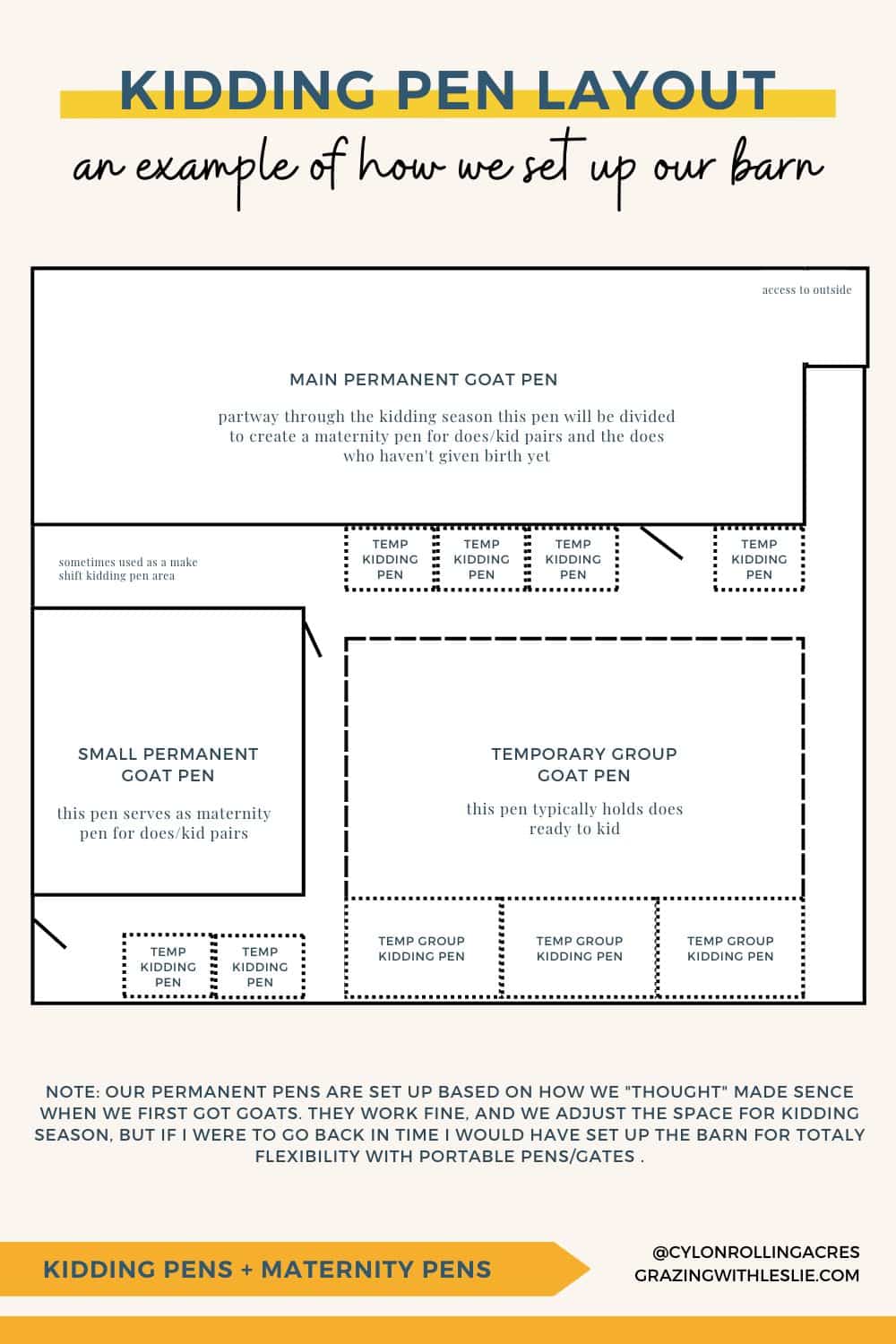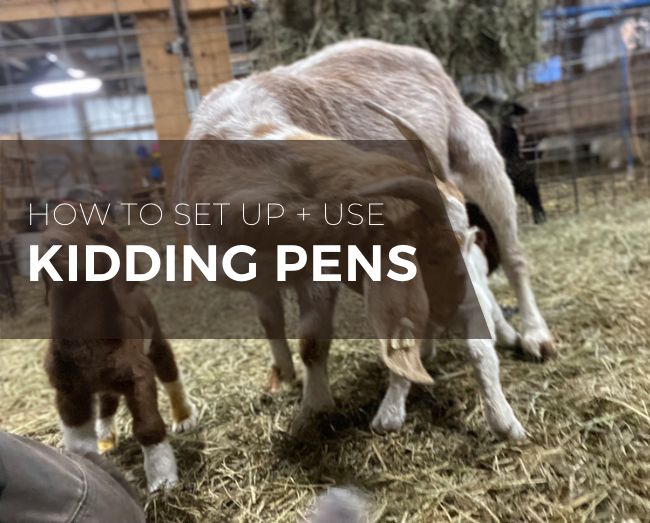I may earn affiliate income from links in the blog post. I only promote products I actually use in my farm and business.
As your goat herd gets closer to kidding, you’ll need to make sure that you’re prepared. Beyond your kidding kit and knowing what to watch for you’ll need to make sure your goat barn is set up with goat kidding pens.
Table of Contents
Table of contents
What are kidding pens
Goat kidding pens, or often called kidding jugs, goat jugs or goat kidding stalls, are simply small pens where does and their new baby goats can stay together to bond.
The number of kidding jugs needed depends on your herd size. A good range is about 1 kidding pen to 7-10 goats, based on recommendations for sheep from the University of Maryland.

When to use kidding pens
Kidding pens are used for 12-48 hours to give the new mom goat time to rest after her labor and delivery, while also letting the new baby goats learn to nurse and bond with their mom.
These goat pens allow the does to take care of her kids without interference or distraction from other goats. She’s also able to eat fresh hay and drink water with little effort.
The baby goats are also able to get the colostrum they need so they get the immunity benefits.
The time spent in the kidding pen depends on how the doe and newborn kids have bonded, the ease or difficulty of kidding, the number of kids, and how the doe and/or the kids are doing in terms of health.
A shorter timer period in the kidding jug may suffice if the does and kids that bond right away, if the mom’s maternal instinct are strong, the kids are healthy and vibrant, and/or if there’s a single kid.
Longer time may be needed in the kidding pen if the birth was more taxing on the doe or kids, if it’s first-time birth for the doe, or bonding started more slowly.
I typically move does and kids into a pen once the doe is done kidding. I like to let the does have their kids in the main pen or yard because it’s less stressful on them to find a space where they are comfortable and away from the rest of the herd to have their babies.
I’ll then use a snow sled to pull the kids to the kidding pen and the mom will usually follow. If not, I’ll put a halter on her and lead her at the same time.
However, if I know a goat is going to have her babies soon and I might not be around to check on them I will often put her in a kidding pen. At night time I usually will do this.

How to use a kidding pen
- Always keep the pen clean and dry. When the doe and kids “graduate” from the kidding jug, clean it out and put new bedding in so it’s ready for the next goat birth.
- Have access to fresh water. Make sure the bucket is secure to the pen wall and kids aren’t able to fall into the bucket.
- Have access to fresh hay.
- Safe space/creep area. This is especially important if kidding pens are smaller to have a safe space so kids aren’t accidentally sat on by their mom. Typically this is a small area in the corner of a pen set up with a board, panel or even a large plastic container with a “mouse hole” to keep mom out but the kids can crawl in. This is typically where a heat lamp might go but take precautions because they can be fire hazards.
- Heat lamp, depending on the season. Be very careful when using heat lamps as they can be a fire hazard.
Kidding pen size
Kidding pens can range in size, depending on your goat barn set up and how many does you have kidding at one time.
Some common kidding pen sizes include:
- 4×4
- 5×5
- 4×6
- 4×8
On our farm, Cylon Rolling Acres, our pens are typically, 4×8 or 8×8 for double occupancy, and if we’re in a pinch for space 4×4.

Different kidding jug options
When setting up kidding pens you can purchase panels/pens or you can take a DIY approach. Here are a few options:
Buying Kidding Pens
- Modular calf hutches
- 4×4 PowerBilt Panels from Premier 1 Supplies
- Kidding or lambing pens from manufactures like Sydell, Lakeland
DIY Kidding Pens
- Pallets with t-posts
- Use existing gates and panels to create group pens
- Cattle panels bent into “Ls” to create small pens, or cut in half for small panels
- Use carabiner style clips or the corkscrew connectors to connect panels together
- Build with lumber
Kidding Pen Creep Area
- Purchase pre-made options that can be added on, or comes with a jug set up
- DIY creep area made with a small section of cattle panel, plastic chain and carabiner clips
Kidding pen set up
When it comes to kidding season, I like to have flexibility in how our barn is set up. In the beginning we have more does who haven’t kidded, but partway through the season it flips and we have more moms with kids than does who haven’t kidded. That’s why I like to have movable pens and gates in my goat barn.

- First I set up a row of kidding pens along our main group pen.
- Next to that is an open area where we will change the pen set up frequently depending on the time of the year. During kidding season, I’ll set it up as a large group pen with kidding pens along the side so I can easily move does and baby goes into the jug.
- In this area I do have radiant heaters above these pens, so if it’s a cold spring or in the evening we will turn them on if we are expecting any doe to give birth that evening.
- Once the does/baby goats graduate from their kidding pens, they’ll move to another group pen I call the maternity ward. This pen usually will hold anywhere from 5-8 does with kids.
- As we kidding season continues we will create a second maternity pen in our main group pen in the back. Over time, we move the divider pen so that the maternity pen gets larger.
- Once we are down to a handful of goats left to give birth, we will “move” the does and kids in the large maternity pen to the front end with access to the yard/pasture, and put the expecting does in the back.
Kidding season with maternity pens and kidding pens is always a bit of a juggling act, but it works quite well.
Portable goat pens vs permanent kidding pens
While permanent kidding goat kidding pens are sturdy and easy to set up, especially if you’re building them with lumber, they don’t offer you a lot of flexibility during kidding season with space.
While a few small permanent pens are ok for having options for sick goats throughout the year, it really is wasted space in your barn outside of kidding season.
This is why I’m a big fan of a portable pen system for kidding season with your kidding pens.
Are jugs needed when kidding on pastures?
In most cases, kidding pens are not needed when your goats are kidding on pasture. But, having an option ready is good for situations when there may be a labor and delivery issue with the goat or it’s a first time mom who needs a little help with the bonding process.
In those situations, a full size cattle panel, a t-post, bucket for water and a few carabiner clips are all you really need to set up a makeshift kidding pen on pasture.
Otherwise, if your pasture has natural shelter or you offer other shelter options, your does should be set up for kidding when the time comes. Of course, you’ll also want to make sure you’re thinking about predator prevention as well. This is where guardian animals can be very helpful.


LEAVE A COMMENT
Comments